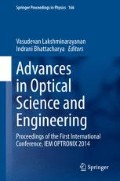Abstract
Copper doped ultra small highly luminescent ZnO nanowires were obtained by modified sol gel route. The zinc acetate mixed with ethanol was used as precursor for the synthesis. Copper doping was done by adding various concentrations of copper chloride. Gel was obtained by magnetically stirring the mixture at 60 °C for 2–3 h and then keeping it for another 24 h for aging. The particles obtained were characterized by XRD, AFM, Optical transmission and photoluminescence studies. X ray diffractogram peak is identified for ZnO. AFM micrograph shows particle alignment in linear direction and formation of nanowires on increasing Cu concentration. The optical band gap of copper doped ZnO shift from 3.2 to 4.76 eV. This strong shift confirms the ultra small size of particles. In PL studies, Undoped ZnO nanostructures exhibit a near-band-edge UV emission at 360 nm and a broad defect related blue emission at 440 nm. Addition of Copper improves the photoluminescence peak in UV region with an additional peak observed in middle UV region at 230 nm. Yellow green or blue makes the nanowires suitable for light emitting devices and biological sensing devices.
Access this chapter
Tax calculation will be finalised at checkout
Purchases are for personal use only
References
Tang ZK, Wang GKL, Yu P, Kawasaki M, Ohtomo A, Koinuma H, Segawa Y (1998) Room-temperature ultraviolet laser emission from self-assembled ZnO microcrystalline thin films. Appl Phys Lett 72:3270–3272
Han WS, Kim YY, Kong BH, Cho HK (2009) Ultraviolet light emitting diode with n-ZnO:Ga/i-ZnO/p-GaN:Mg heterojunction. Thin Solid Films 517:5106–5109
Zhang L, Zhao J, Lu H, Li L, Zheng J, Li H, Zhu Z (2012) Highly sensitive and selective dimethylamine sensors based on hierarchical ZnO architectures composed of nanorods and nanosheet-assembled microspheres. Sens Actuators B Chem 171–172:1101–1109
Chow L, Lupan O, Chai G, Khallaf H, Ono LK, Cuenya BR, Tiginyanu IM, Ursaki VV, Sontea V, Schulte A (2013) Synthesis and characterization of Cu-doped ZnO one-dimensional structures for miniaturized sensor applications with faster response. Sens Actuators A 189:399–408
Ferhat M, Zaori A, Ahuja R (2009) Magnetism and band gap narrowing in Cu-doped ZnO. Appl Phys Lett 94:142502
Lu H, Wang Y, Lin X (2009) Structures, varistor properties, and electrical stability of ZnO thin films. Mater Lett 63:2321–2323
Dedova T, Acik IO, Krunks M, Mikli V, Volobujeva O, Mere A (2012) Effect of substrate morphology on the nucleation and growth of ZnO nanorods prepared by spray pyrolysis. Thin Solid Films 520:4650–4653
Thakur V, Verma UP, Rajaram P (2013) Solvent dependent growth of fibrous and non-fibrous nanocrystalline thin films of ZnO. J Sol-Gel Sci Technol 66(2):280–287
Kiyotaka M, Kazuyuki H, Shimotuma Y (2011) Nanotechnology and Nanomaterials. In: Abass H (ed) Nanowires—fundamental research, InTech, Rijeka
Ozgur U, Morkoç H (2006) Optical properties of ZnO and related alloys. In: Jagadish C, Pearton S (eds) Zinc oxide bulk, thin films and nanostructures, Elsevier, Amsterdam, pp 175–239
Burstein E (1954) Anomalous optical absorption limit in InSb. Phys Rev 93:632–633
Ilican S, Caglar Y, Claglar M (2008) Preparation and characterization of ZnO thin films deposited by sol-gel spin coating method. J Opto Electron Adv Mater 10:2578–2583
Acknowledgments
The authors are thankful for providing XRD and AFM facility to UGC-DAE consortium for scientific research Indore India and P C Ray research centre, ITM University Gwalior (MP) for providing optical and photoluminescence facilities.
Author information
Authors and Affiliations
Corresponding author
Editor information
Editors and Affiliations
Rights and permissions
Copyright information
© 2015 Springer India
About this paper
Cite this paper
Gahlaut, U.P.S., Kumar, V., Pandey, R.K., Goswami, Y.C. (2015). Growth of Blue Luminescent Cu Doped ZnO Nanowires by Modified Sol-Gel. In: Lakshminarayanan, V., Bhattacharya, I. (eds) Advances in Optical Science and Engineering. Springer Proceedings in Physics, vol 166. Springer, New Delhi. https://doi.org/10.1007/978-81-322-2367-2_43
Download citation
DOI: https://doi.org/10.1007/978-81-322-2367-2_43
Published:
Publisher Name: Springer, New Delhi
Print ISBN: 978-81-322-2366-5
Online ISBN: 978-81-322-2367-2
eBook Packages: Physics and AstronomyPhysics and Astronomy (R0)

